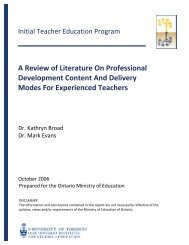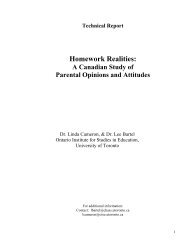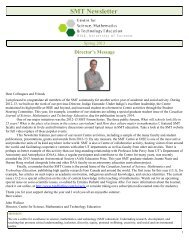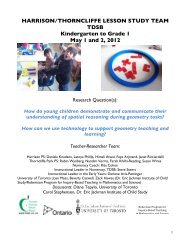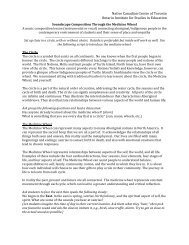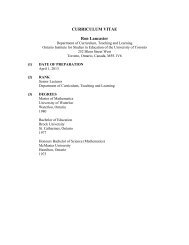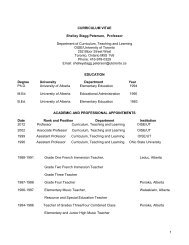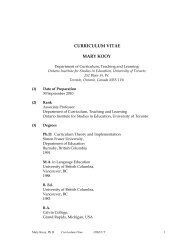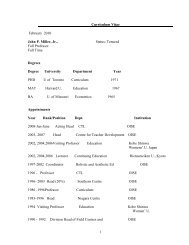The Ontario Curriculum, Grades 9-12 - Ministère de l'éducation ...
The Ontario Curriculum, Grades 9-12 - Ministère de l'éducation ...
The Ontario Curriculum, Grades 9-12 - Ministère de l'éducation ...
Create successful ePaper yourself
Turn your PDF publications into a flip-book with our unique Google optimized e-Paper software.
forest fires, and on changes in weather systems or the atmosphere. But satellites use huge<br />
amounts of fuel, and old satellites often become space junk.<br />
Sample questions: How are large-scale centrifuges used in wastewater treatment? How<br />
do windmills use the principles of dynamics to generate power? What is the<br />
environmental impact of wind power and wind farms? How are linear actuators used to<br />
make the workplace more ergonomic, reducing work days lost to strain and injury?<br />
C. Energy and Momentum<br />
C1. Relating Science to Technology, Society, and the Environment<br />
C1. analyse, and propose ways to improve, technologies or procedures that apply principles<br />
related to energy and momentum, and assess the social and environmental impact of these<br />
technologies or procedures<br />
C1.2 assess the impact on society and the environment of technologies or procedures that<br />
apply the principles of energy and momentum (e.g., crumple zones, safety restraints,<br />
strategic building implosion) [AI, C]<br />
Sample issue: Hydroelectricity is produced by using the potential energy of dammed<br />
water to drive turbines and generators. Although hydroelectricity is renewable and<br />
generates no greenhouse gases, the damming of waterways can create massive flooding<br />
upstream and reduce flows downstream, affecting aquatic and terrestrial ecosystems and<br />
people living near the water source.<br />
Sample questions: … What is the environmental impact of the chemicals whose<br />
combustion produces the effects in fireworks displays?<br />
D. Gravitational, Electric, and Magnetic Fields<br />
D1. Relating Science to Technology, Society, and the Environment<br />
D1. analyse the operation of technologies that use gravitational, electric, or magnetic fields,<br />
and assess the technologies’ social and environmental impact<br />
D1.2 assess the impact on society and the environment of technologies that use gravitational,<br />
electric, or magnetic fields (e.g., satellites used in surveillance or storm tracking, particle<br />
accelerators that provi<strong>de</strong> high-energy particles for medical imaging) [AI, C]<br />
Sample issue: <strong>The</strong> radiation produced by the magnetic and electric fields of electron<br />
accelerators is used to treat tumours. In conjunction with other therapies, radiation<br />
increases the survival rate of cancer patients, but safeguards are nee<strong>de</strong>d to ensure that<br />
patients receive safe doses of radiation and that medical personnel and the immediate<br />
environment are not contaminated.<br />
Sample questions: … What is the effect on human health of long-term exposure to the<br />
electrical fields created by high-voltage lines? How could zero-gravity experiments on<br />
agricultural products benefit society and the environment? What are the environmental<br />
benefits of using technology involving gravitational fields to search for mineral <strong>de</strong>posits?<br />
E. <strong>The</strong> Wave Nature of Light<br />
E1. Relating Science to Technology, Society, and the Environment<br />
E1. analyse technologies that use the wave nature of light, and assess their impact on society<br />
and the environment<br />
Science 149



